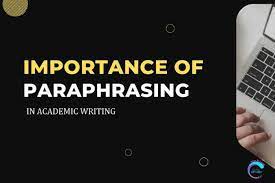
Paraphrasing, often overlooked in the realm of communication, holds immense importance in facilitating comprehension, enhancing originality, and fostering effective communication. It’s the art of rephrasing information in one’s words while retaining the core essence and meaning. This skill transcends various domains, from academia to professional settings, where clear, concise, and original expression is valued.
Firstly, paraphrasing plays a pivotal role in comprehension. When we paraphrase, we engage with the material actively, processing it and restructuring it in a way that aligns with our own understanding. This process encourages us to delve deeper into the content, dissecting it into comprehensible chunks and ensuring that we genuinely grasp the underlying concepts. In educational settings, paraphrasing serves as a gauge of true comprehension, showcasing an individual’s ability to reframe complex information into simpler, more digestible forms.
Moreover, paraphrasing acts as a tool for enhancing originality and authenticity. In a world flooded with information, the ability to rephrase thoughts and ideas without distorting their essence becomes crucial. It encourages individuals to express their unique perspectives, avoiding plagiarism while acknowledging the original source. In academic writing, this skill is fundamental, as it allows students and researchers to integrate existing knowledge into their work while maintaining academic integrity.
In professional settings, paraphrasing becomes a cornerstone of effective communication. It aids in avoiding misunderstandings by ensuring that messages are relayed accurately. When paraphrasing, individuals must actively listen, comprehend, and reframe ideas, fostering better communication and collaboration within teams. It minimizes the risk of misinterpretation, aligning everyone’s understanding and promoting a more cohesive work environment.
Furthermore, paraphrasing is invaluable in cross-cultural communication. In a diverse world where languages and cultural nuances vary, paraphrasing helps bridge communication gaps. It enables individuals to express complex ideas in simpler terms, facilitating understanding among people from different linguistic backgrounds. Through paraphrasing, the essence of the message remains intact while being tailored to suit the audience’s cultural context and language proficiency.
The significance of paraphrasing extends beyond written and spoken communication—it influences critical thinking. When paraphrasing, individuals are required to analyze and synthesize information, honing their cognitive skills. It encourages active engagement with content, prompting individuals to question, evaluate, and articulate information in their own words. This process strengthens analytical abilities, fostering a deeper level of understanding.
In essence, the importance of paraphrasing lies in its multifaceted nature. It’s not merely about rephrasing words; it’s about understanding, interpreting, and expressing information authentically. Whether in academia, professional settings, or everyday communication, the ability to paraphrase empowers individuals to comprehend, communicate effectively, and contribute original thoughts to the discourse.
To cultivate this skill, practice and patience are key. Actively engage with diverse materials, challenge yourself to rephrase complex ideas in simpler terms, and consistently seek feedback to refine your paraphrasing abilities. Embracing paraphrasing as a valuable communication tool not only elevates individual expression but also enriches the collective exchange of ideas, fostering a world where understanding and originality thrive.


